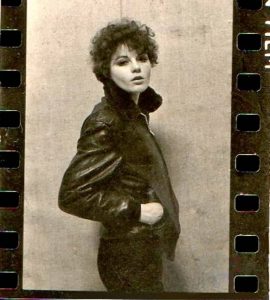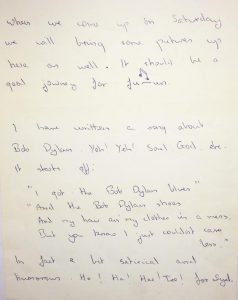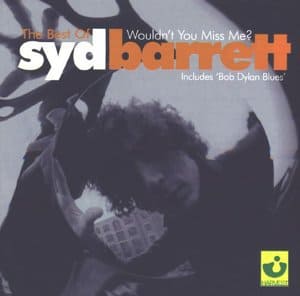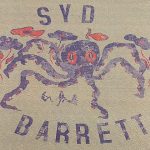The song Bob Dylan Blues is a very early song by Syd Barrett, written early in 1965 but not recorded until during the February 1970 sessions for the album ‘Barrett’. It was thought lost until it turned up after 30 years in a tape collection at home by David Gilmour, and was released on ‘The Best of Syd Barrett’ in 2001. The song is similar to ‘Effervescing Elephant’ in that it reflects the creativity of a young Syd Barrett with its humour and word play.
Girl friend Libby Gausden remembers how, as a birthday present, she was taken to see Bob Dylan with Syd in May 1964, in London. ‘We arrived at the South Bank and he said, “Look, it’ s the me and you from every town.” Each town sent one Syd Barrett, the first time I’d seen people like him,’ recalled Libby. Three years later, this is the location where Syd would triumph in ‘Games for May’– little did he know…
‘The Freewheelin’ Bob Dylan’ was released in USA in May 1963, but in UK only in November. Soon Freewheelin’ sat at Number One in the charts, and during 1964 ‘The Times They Are A’ Changin’ followed with, in November that year, ‘Another Side of Bob Dylan’. That last album contains the song ‘ I Shall Be Free #10’ and the lyric, ‘ I’m a poet; I know it, hope I don’ t blow it.’ Syd, as always a clever collage artist, picked bits and pieces from all these albums to write a very personal parody of, and in the style of, Bob Dylan.
The music itself is in the style of waltz tempo ‘Chimes of Freedom’ featuring similar chords. The song title is akin to what was used on ‘Freewheelin’, with Dylan’ s own name in not one but two song titles of the album – quite an achievement for a new artist: ‘Bob Dylan’s Blues’and ‘Bob Dylan’s Dream.’ When Syd sings “the wind you can blow it” it is a common reference from several of Dylan’s songs, as are the shoes and the hat references. The rhyming of “dreams” and “seems” occurs in ‘Talking World War III Blues’ and “war in the cold” comes from ‘Masters Of War.’


This is a photo of his then girl friend Jenny Spires, taken by Syd himself. Jenny comments:“this pic Syd took of me in v. early 67. the jacket was cool… the satin trousers from Granny’s, where else? at that time. But def. The Bob Dylan Cut.”
The letter (right), from Syd to Jenny, documents the origins of Bob Dylan Blues:”I have written a song about Bob Dylan. Yeh! Yeh! Soul, God, etc. It starts off “I got the Bob Dylan blues and the Bob Dylan shoes and my hair an’ my clothes in a mess but you know I just couldn’t care less”. In fact a bit satirical and humorous. Ho! Ha! Hee! Tee! for Syd.”
Jenny tells us this fascinating story about the background and the letter:“By 1965 Syd or ‘Rog’, as he’d sign himself, was writing to me two or three times a week. He was at Camberwell Art School and now that he had settled into Stanhope Gardens, he wanted to take some of his paintings there. This letter came late January/early February 1965.
Before I knew Syd, I had been listening to Dylan and a range of folk, blues and rock which we discovered we were both into. So, when he sent me this verse it didn’t seem that unusual at the first. Typically, it just made me laugh.
Like him, it’s full of humour, ‘a bit satirical’ , he writes, ‘ Quiet while I make like cat’ , ‘ my gut and my wallet are fat’ , ‘ buy all my discs and a hat’ , hilarious. It’ s also a homage to ‘ Dylan’ , who Syd identifies himself with, ‘ Cause I’m Mr. Dylan the King’. It’ s ingenious. Syd, with his painterly eye, could always transcend. In the simplest terms we learn that Dylan the King sings ‘ bout God and my girl’ , ‘ bout what’ s right and what’ s wrong’ , about ‘ dreams’ and what ‘ seems’ . And, he could ‘ prophesy all kinds of things’.
For me, at this time, the song was about that ‘Freewheelin’, carefree concept we got into. It’ s a move towards a freer and better world away from the one we see in ‘ Song To Woody’ , ‘ A Man of Constant Sorrow’ , ‘Hard Rains’ and ‘ Don’ t Think Twice’ . Dylan was a huge influence on us all at the time. His songs were our protest.
So, that weekend, as we were driving to London, cruising down the A1, as much as one can in a blue Austin A30 with the indicator switch on the dashboard, I learnt the rest of the song. Syd had several little songs on the go that we sang to … and I was used to hearing him play acoustic guitar, but this song played with all its Dylanesque resonance, is beautiful.
At the time, seeing Syd full throttle in a band came as no surprise to me. He was good. The old T Set/Floyd blues band doing ‘King Bee’ and his songs ‘Lucy Leave’ and ‘Double O’ Bo’ was exciting. Syd’ s development as a song writer took hold rapidly. Within a year the band was moving into, what we called, ‘free’ improvisation, and with the free flow of Syd’ s lyrics, in songs like ‘Astonomy Domine’ and ‘Chapter 24’, he became a considerable influence.”
Bob Dylan was of course a phenomenal influence on many people. In the case of Pink Floyd, even though it is not obviously reflected in their music, Dylan was a hero for all their main three creative leaders. Syd wrote a song in his honour. Roger Waters often refers to Dylan as an inspiration and he has, in later days, become something of the protest singer Dylan started out as. David Gilmour received Dylan’s début album from his parents in the USA long before it was released in UK.
Two years after Syd’s song, Bob Dylan had grown in importance and after his motorcycle accident and disappearance in mid 1966, to almost mythical levels, affecting many parts of the culture. Roger Waters, in one of his songs on ‘The Wall’, sings of the “obligatory Hendrix perm”; something which Jimi Hendrix in fact had adopted from Bob Dylan in his admiration of him. So in reality it was a “Dylan perm” – and for some people more than others.
Jenny remembers:-“Over the Christmas holiday of 1966, Syd played me an acoustic version of his song Arnold Layne; deep down a protest song. The Floyd were to record and release it as a single in the New Year. In the meantime, Peter Whitehead had shown me the rushes for his film, ‘ Tonite Let’ s all Make Love in London’ but he was agonising over a soundtrack. I suggested he use the Floyd’ s ‘Interstellar Overdrive’ and luckily, after hearing them, he agreed. Within a week Peter booked Sound Techniques and we went in to film them just before the Arnold Layne sessions.
Before my return to London after the holiday, I had my hair bubbled. When Syd saw it his eyes literally shone. There were several people on the scene who had this wonderful, if strange, ‘Aubrey Beardsley’ hair style. Some of them naturally, and others following, but initially it was done in that image of Dylan on the cover of ‘Blonde on Blonde’, which we had endlessly listened to, and identified with, the previous year. Quite soon, that hairstyle also became associated with Hendrix too. There was a buzz growing about him in London and, in the event, I did meet him before I saw him play at The Saville Theatre for the first time.”
For Jenny then, this is certainly a very special song, close to her heart. When the song was rediscovered and released in 2001, it was a surprise and a gift to many of us.
Jenny remembers:-“When I heard ‘The Bob Dylan Blues’ again, after all those years, I was amazed and marvelled at it all over again. It took me right back to the time when Syd was joyful about everything. I really think people love that song now. I hope Dylan does too. I won’t forget it again and am so grateful to Malcolm Jones and David Gilmour for having recorded it and kept it safe and unadulterated over the years because it’s quintessentially, impeccable Barrett.”
David Gilmour commented about the song, which must have been dear to him also: “Bob Dylan Blues is a bit of fun. He was quite a Dylan fan, though there was a bit of jealousy there, too. If a tribute, then a mocking one!”
(Very many thanks to Jenny for permission to publish these personal mementos and her reminiscences)
Song by Syd Barrett from the album 'The Best of Syd Barrett/Wouldn't You Miss Me?'
Genre: Folk rock, blues rock
Length: 3:14
Label: Harvest (UK), Capitol Records (US)
Writer: Syd Barrett
Producer: David Gilmour





